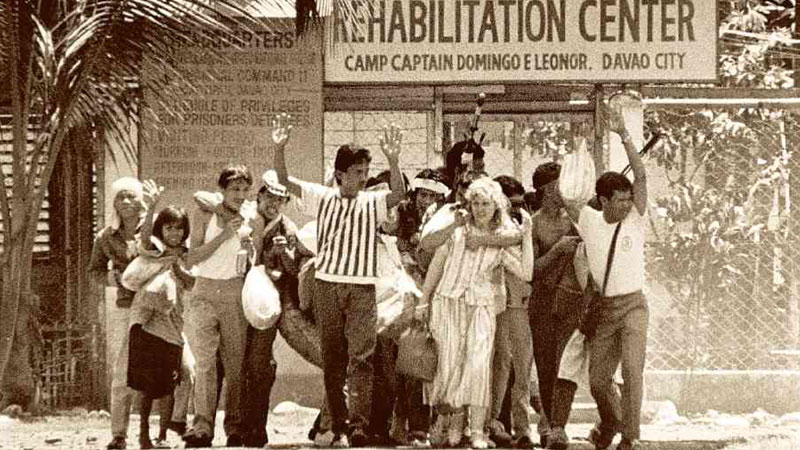
BLOODY HOSTAGE DRAMA This photo taken on Aug. 15, 1989, by former Inquirer chief photographer Boy Cabrido shows Australian missionary Jacqueline Hamill and other hostages used as human shields by armed inmates at the Metrodiscom detention center in Camp Leonor in Davao City. INQUIRER FILE PHOTO
ON AUG. 13, 1989, inmates at the Metrodiscom detention center in Camp Leonor in Davao City overran a guardhouse of the facility, seized rifles from jail guards and grabbed 15 hostages, including Australian missionary Jacqueline Hamill.
Hamill, a member of the Protestant group Joyful Assemblies of God, arrived in the Philippines a month earlier. She and several other Protestant missionaries were in the detention center for a Bible-sharing fellowship. It was her first jail ministry in the country.
The prisoners, who had reportedly called themselves “Wild Boys of Dapecol,” held the hostages for two nights and three days until a military assault on Aug. 15, 1989, which killed 16 inmates and five hostages, including Hamill.
According to an initial report, Hamill was raped, slashed in the throat and shot in the neck.
One of the hostages who survived said Hamill had told her that the prisoners had raped her at knife-point.
The parents of Hamill, Jean and Ray, described their daughter as a Christian who wanted to help “the small people.” Ray criticized the Philippine military for staging the assault.
Days after the incident, Davao City Mayor Rodrigo Duterte said the military assault was the “only civilized option available to government at the time.” The decision to mount the operation, he said, was “collective.”
“Of course, the loss of five lives is most unfortunate. The order was to save lives and to apprehend criminals but that if they resisted, they would be shot,” the mayor said.
He also took a potshot at then Sen. Ernesto Maceda, chair of the Senate defense committee, who criticized the military for the assault.
According to an eight-page report submitted by then Brig. Gen. Felix Brawner Jr. to the Senate committee on national defense, Duterte and other civilian officials, who were part of the negotiating team, issued shoot-to-kill orders to troops shortly before bloody assault started.
The negotiating panel was composed of then Davao del Sur Gov. Douglas Cagas, chair of the Regional Peace and Order Council and then Justice Undersecretary Silvestre Bello and Jesus Dureza.
The inmates, led by former Air Force man Mohammad Nazir Samparani and Felipe Pugoy, were transferred to the Metrodiscom detention center in Davao City after they seized 14 women from the Davao Penal Colony (Dapecol) in Panabo, Davao del Norte.
The inmates took the hostages in April of the same year through hundreds kilometers of highway in Southern Mindanao, transferring from one vehicle to another until they returned to Davao City.
The inmates, who complained of inhuman treatment in Dapecol, released the hostages only after they were promised that they would be transferred to the National Penitentiary in Muntinlupa City.
This, however, never happened because they had to be arraigned for the kidnapping charges filed by the hostages in the Dapecol jailbreak. Most of them were transferred to Metrodiscom. Inquirer Research
Sources: Inquirer Archives